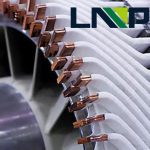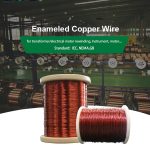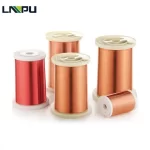The manufacturing process of copper wire involves several stages, from the extraction of raw materials to the final product. This overview will cover the main steps, including wire drawing, annealing, insulation coating (if applicable), and quality control measures.
1. Raw Material Preparation
Copper wire manufacturing begins with the extraction and refining of raw copper materials from mines. The copper is typically extracted through open-pit mining or underground mining, depending on the location and depth of the copper deposits.
Once extracted, the raw copper is processed and purified through smelting and electrolytic refining to produce high-purity copper cathodes.
2. Wire Drawing
The next step in the manufacturing process is wire drawing, which involves reducing the diameter of the copper wire by pulling it through a series of dies. The copper cathodes are first melted and cast into large copper rods.
These rods are then fed into a wire drawing machine, which pulls the copper through a series of consecutive dies, each with a smaller diameter than the previous one. This process gradually reduces the diameter of the copper wire while increasing its length. The result is a long, thin, and uniform copper wire.
3. Annealing
After the wire drawing process, the copper wire undergoes annealing. This is a heat treatment process that softens the copper wire and improves its ductility, conductivity, and flexibility.
The annealing process involves heating the drawn copper wire to a specific temperature range (usually between 350°C and 600°C) and then cooling it gradually.
4. Insulation Coating (if applicable)
Depending on the intended application of the copper wire, an insulation coating may be applied to provide electrical insulation and protection from environmental factors. There are various types of insulation materials available, such as PVC (polyvinyl chloride), PE (polyethylene), and XLPE (cross-linked polyethylene).
The insulation process typically involves passing the copper wire through an extruder, which applies a uniform layer of the chosen insulation material around the wire. After the insulation is applied, the wire is cooled and subjected to quality control measures to verify the thickness and uniformity of the insulation.
5. Quality Control Measures
Throughout the manufacturing process, strict quality control measures are implemented to ensure that the final copper wire product meets industry standards and customer requirements. Some typical quality control measures include:
-
Visual inspection: Inspecting the wire for surface defects, imperfections, and uniformity throughout the process.
-
Dimensional checks: Verifying the diameter of the drawn wire and the thickness of the insulation, if applicable, using precision measurement tools such as micrometers and calipers.
-
Conductivity tests: Measuring the electrical conductivity of the copper wire to ensure that it meets the required specifications. This is typically done using a four-point probe method or an eddy current test.
-
Tensile strength tests: Assessing the wire’s tensile strength and elongation properties by applying a controlled force to the wire until it breaks. This test ensures that the wire can withstand the mechanical stresses it may encounter during installation and use.
-
Insulation resistance tests: Confirming the electrical insulation properties of the wire by measuring its resistance to the flow of electric current. This is typically done using a high-voltage insulation resistance tester, also known as a “megger.”
-
Flammability tests: Evaluating the fire resistance of the insulation material by exposing it to a flame under controlled conditions. This test ensures that the wire meets the required flammability standards for its intended application.
6. Packaging and Shipping
Once the copper wire has passed all the quality control measures, it is wound onto spools or reels of various sizes, depending on customer requirements. These spools or reels are then labeled with relevant information such as wire gauge, length, and insulation type. Finally, the packaged copper wire is prepared for shipping to distributors, wholesalers, or end users.
LP Industry can produce magnet wires according to your requirement with best prices, check our website to learn more: https://transformer-wire.com





